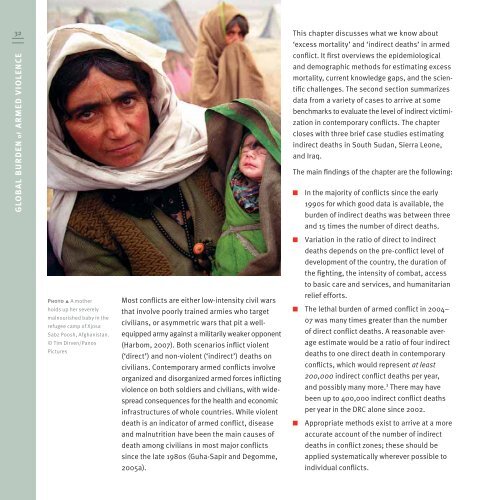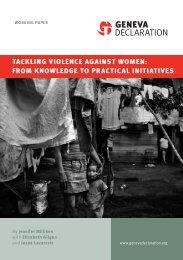Global Burden of Armed Violence - The Geneva Declaration on ...
Global Burden of Armed Violence - The Geneva Declaration on ...
Global Burden of Armed Violence - The Geneva Declaration on ...
Create successful ePaper yourself
Turn your PDF publications into a flip-book with our unique Google optimized e-Paper software.
32 This chapter discusses what we know about<br />
GLOBAL BURDEN <str<strong>on</strong>g>of</str<strong>on</strong>g> ARMED VIOLENCE<br />
Photo ! A mother<br />
holds up her severely<br />
malnourished baby in the<br />
refugee camp <str<strong>on</strong>g>of</str<strong>on</strong>g> Xjosa<br />
Sabz Poosh, Afghanistan.<br />
© Tim Dirven/Panos<br />
Pictures<br />
Most c<strong>on</strong>flicts are either low-intensity civil wars<br />
that involve poorly trained armies who target<br />
civilians, or asymmetric wars that pit a well-<br />
equipped army against a militarily weaker opp<strong>on</strong>ent<br />
(Harbom, 2007). Both scenarios inflict violent<br />
(‘direct’) and n<strong>on</strong>-violent (‘indirect’) deaths <strong>on</strong><br />
civilians. C<strong>on</strong>temporary armed c<strong>on</strong>flicts involve<br />
organized and disorganized armed forces inflicting<br />
violence <strong>on</strong> both soldiers and civilians, with wide-<br />
spread c<strong>on</strong>sequences for the health and ec<strong>on</strong>omic<br />
infrastructures <str<strong>on</strong>g>of</str<strong>on</strong>g> whole countries. While violent<br />
death is an indicator <str<strong>on</strong>g>of</str<strong>on</strong>g> armed c<strong>on</strong>flict, disease<br />
and malnutriti<strong>on</strong> have been the main causes <str<strong>on</strong>g>of</str<strong>on</strong>g><br />
death am<strong>on</strong>g civilians in most major c<strong>on</strong>flicts<br />
since the late 1980s (Guha-Sapir and Degomme,<br />
2005a).<br />
‘excess mortality’ and ‘indirect deaths’ in armed<br />
c<strong>on</strong>flict. It first overviews the epidemiological<br />
and demographic methods for estimating excess<br />
mortality, current knowledge gaps, and the scien-<br />
tific challenges. <str<strong>on</strong>g>The</str<strong>on</strong>g> sec<strong>on</strong>d secti<strong>on</strong> summarizes<br />
data from a variety <str<strong>on</strong>g>of</str<strong>on</strong>g> cases to arrive at some<br />
benchmarks to evaluate the level <str<strong>on</strong>g>of</str<strong>on</strong>g> indirect victimi-<br />
zati<strong>on</strong> in c<strong>on</strong>temporary c<strong>on</strong>flicts. <str<strong>on</strong>g>The</str<strong>on</strong>g> chapter<br />
closes with three brief case studies estimating<br />
indirect deaths in South Sudan, Sierra Le<strong>on</strong>e,<br />
and Iraq.<br />
<str<strong>on</strong>g>The</str<strong>on</strong>g> main findings <str<strong>on</strong>g>of</str<strong>on</strong>g> the chapter are the following:<br />
In the majority <str<strong>on</strong>g>of</str<strong>on</strong>g> c<strong>on</strong>flicts since the early<br />
1990s for which good data is available, the<br />
burden <str<strong>on</strong>g>of</str<strong>on</strong>g> indirect deaths was between three<br />
and 15 times the number <str<strong>on</strong>g>of</str<strong>on</strong>g> direct deaths.<br />
Variati<strong>on</strong> in the ratio <str<strong>on</strong>g>of</str<strong>on</strong>g> direct to indirect<br />
deaths depends <strong>on</strong> the pre-c<strong>on</strong>flict level <str<strong>on</strong>g>of</str<strong>on</strong>g><br />
development <str<strong>on</strong>g>of</str<strong>on</strong>g> the country, the durati<strong>on</strong> <str<strong>on</strong>g>of</str<strong>on</strong>g><br />
the fighting, the intensity <str<strong>on</strong>g>of</str<strong>on</strong>g> combat, access<br />
to basic care and services, and humanitarian<br />
relief efforts.<br />
<str<strong>on</strong>g>The</str<strong>on</strong>g> lethal burden <str<strong>on</strong>g>of</str<strong>on</strong>g> armed c<strong>on</strong>flict in 2004–<br />
07 was many times greater than the number<br />
<str<strong>on</strong>g>of</str<strong>on</strong>g> direct c<strong>on</strong>flict deaths. A reas<strong>on</strong>able aver-<br />
age estimate would be a ratio <str<strong>on</strong>g>of</str<strong>on</strong>g> four indirect<br />
deaths to <strong>on</strong>e direct death in c<strong>on</strong>temporary<br />
c<strong>on</strong>flicts, which would represent at least<br />
200,000 indirect c<strong>on</strong>flict deaths per year,<br />
and possibly many more. 3 <str<strong>on</strong>g>The</str<strong>on</strong>g>re may have<br />
been up to 400,000 indirect c<strong>on</strong>flict deaths<br />
per year in the DRC al<strong>on</strong>e since 2002.<br />
Appropriate methods exist to arrive at a more<br />
accurate account <str<strong>on</strong>g>of</str<strong>on</strong>g> the number <str<strong>on</strong>g>of</str<strong>on</strong>g> indirect<br />
deaths in c<strong>on</strong>flict z<strong>on</strong>es; these should be<br />
applied systematically wherever possible to<br />
individual c<strong>on</strong>flicts.









